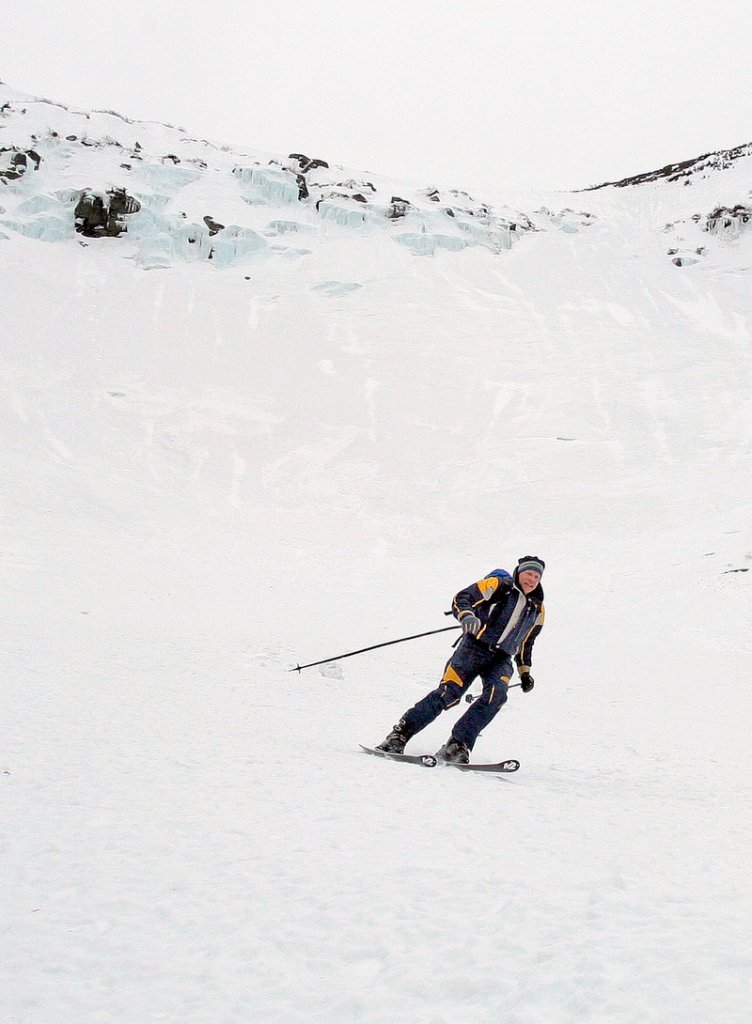It never ceases to amaze me that skiers and boarders I know who complain about bitter cold, biting winds and often variable conditions in December and January, hang ’em up when March and April come along, with what is often the best skiing of the season.
In fact, March is frequently the snowiest month of the year in the north country, combining new snow with improving temperatures resulting from a sun angle that gives us longer hours and warmer days. And April can often bring us meaningful storms as well.
But with the advent of spring, and the urge to rip it up on corn surfaces, there are a few precautions it’s worth keeping in mind.
First, surface conditions can change not only day to day but run to run. So the trail you took in the morning on crisp spring snow can be glop toward midday, and east- and south-facing pitches that were completely covered at 9 a.m. could well be showing bare spots and even more hazardous impediments, like rocks and stumps, by late morning. And, conversely, soft midday conditions can morph back to frozen granular in the late afternoon.
My personal nemesis, nine Aprils ago, was a pitch on a blue trail into which I sunk when I landed after a little air, buried a ski and soon after wound up in the hospital in Farmington with a shattered tibial plateau, followed by a few long months of rehab. The upside is that it was the next-to-last weekend of the season, so I only missed one week! And I did adjust the DIN setting on my toe release downward from eight to six the following season.
In addition to increased awareness of condition changes, be sure to protect exposed skin from the harmful effects of the sun reflecting off the snow, with liberal applications of sunscreen and lip balm.
Maine skiers and boarders are blessed that several areas traditionally operate well into April, and often into early May.
Sugarloaf and Sunday River continue their long competitive tradition, despite common ownership, to vie for last-in-the- spring in the East honors, although a perfect equilibrium seems to have been reached in recent years, with Sunday River taking the first-to-open honors in the fall, and Sugarloaf capturing the late-closing crown.
Over in Rangeley, Saddleback’s elevation and northwest exposure guarantee good cover well into late spring. Aren’t we lucky to live in Maine?
Then there are those diehards who can’t let go after the ski areas have wrapped up their seasons, who climb to patches of snow on sheltered trails. And a shout out to manufactured snow with its high water content, making it less susceptible to warm temperatures. So on those trails with deep cover, snow can be found often into June, and there are skiers who trudge up to enjoy it in Maine’s western mountains.
My wife and I often spend Memorial Day weekend in Quebec City, and there’s one trail at neighboring Mount Saint Anne that always has a patch of snow. Last year, as we headed further north to explore the Charlevoix/Saguenay River wilderness, we found a huge pile of snow at the top of Le Massif, about an hour north of the city. And since that spectacular ski area is upside-down (you drive to the lodge at the summit, as the base is 2,600 feet straight down on the banks of the St. Lawrence River), it was easily accessible.
Then there’s the granddaddy of them all for eastern skiers: Tuckerman Ravine.
It’s a bit of a trek, about 3 miles in from Route 16 in Pinkham Notch, and a stop at Crystal Cascade waterfall half a mile in is a must. The reward-to-exertion ratio is very high once you reach the bowl itself.
The 50-degree head wall isn’t for the faint of heart, but the concave face allows you to ascend only as far as your courage — and judgment — dictate.
I will tell you, that first trip over the lip is a heart-stopper. Mine was nearly 60 years ago, and the memory is as vivid as if it were yesterday. And the camaraderie of the crowd at Luncheon Rocks is reason enough to make the trip.
Thanks to the efforts of legendary Wildcat patroller, Al Risch, and loyal supporters, the Friends of Tuckerman (at www. friendsoftuckerman.org) formed some 11 years ago “to preserve and protect the unique alpine and eastern slopes of Mount Washington.”
The group is reviving the great tradition of the ravine, including scheduling the Inferno race each year. This year it will take place April 15-17, and will feature other competitions besides the race down the head wall.
Although my kayak looks like it’s straining to get down from its hangers in my barn, my hiking boots are greased and my motorcycle’s already scheduled for its spring tune-up, those toys are just going to have to wait, as I’m looking forward to another month or more of the best skiing of the year.
John Christie is a former ski racer and ski area manager and owner, a ski historian and member of the Maine Ski Hall of Fame. He and his son, Josh, write ski columns on alternating weeks. John can be reached at:
jchristie@fairpoint.net
Send questions/comments to the editors.



Success. Please wait for the page to reload. If the page does not reload within 5 seconds, please refresh the page.
Enter your email and password to access comments.
Hi, to comment on stories you must . This profile is in addition to your subscription and website login.
Already have a commenting profile? .
Invalid username/password.
Please check your email to confirm and complete your registration.
Only subscribers are eligible to post comments. Please subscribe or login first for digital access. Here’s why.
Use the form below to reset your password. When you've submitted your account email, we will send an email with a reset code.